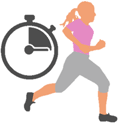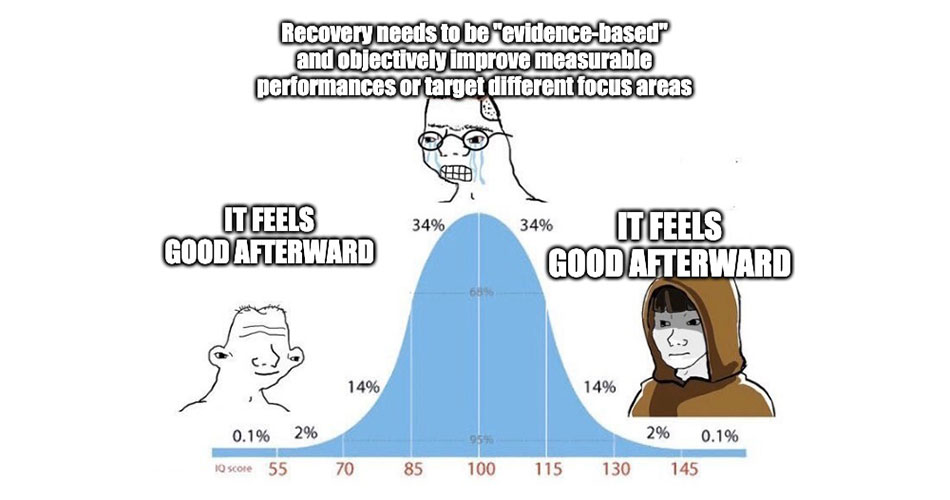Do We Need to Perform a Cool-Down After Exercise?
Introduction
Many recreational and professional athletes frequently perform 5-15 minutes of low to moderate intensity exercises or movements after their training or competition in an attempt to improve recovery and hereby enhance subsequent performance and reduce injuries. This recovery method is widely known as a cool-down. Does a cool-down however actually improve post-exercise recovery? In a recent comprehensive and freely-available review published in Sports Medicine, Jonathan Peake and I attempted to answer this question by analyzing more or less all research that has investigated the effects of cool-downs on psychophysiological recovery (Van Hooren & Peake, 2018). We also reviewed the effects on injuries and adaptation to exercise. Here I will summarize the most important findings and provide practical applications.
What is a cool-down?
Before I can summarize all findings, we first need to agree on what we consider as a cool-down. We defined a cool-down as “an activity that involves voluntary, low- to moderate-intensity exercise or movement performed within 1 h after training and competition (Van Hooren & Peake, 2018).” Important here is therefore that we did not include studies that investigated the effects of ‘active recovery’ performed on the next day after exercise, for example cycling the day after a hard soccer match. Further, we were interested in investigating whether performing an active cool-down was better than doing nothing at all, which we have referred to as a passive cool-down. This involves sitting, lying, or standing (no walking).
Does it improve recovery?
Whether an active cool-down improves recovery is a more challenging question to answer than it might seem at the first place because recovery is a very broad concept and because there are many different forms of an active cool-down. Figure 1 shows the proposed psychophysiological (i.e., recovery) benefits of an active cool-down such as a faster removal of lactate in blood and muscle, a reduction in muscle soreness and less stiffness. If we want to know whether an active cool-down enhances recovery, we therefore need to consider of all these potential effects.
Ideally we also need to investigate whether different active cool-downs have different effects, while simultaneously considering the different training or competitions performed and individual characteristics. For example, is it more effective to perform low-intensity cycling or running after the training/competition? And is it more effective to do this for 30 minutes or 10 minutes? Does the cool-down set-up differ if I have performed 15 minutes of high-intensity swimming or a 90 minutes of soccer match? And finally, should the cool-down be different for a well-trained athlete and a recreationally trained individual? Unfortunately, we cannot answer all questions as there is simply not enough research out there that has investigated all these specific effects. I hope this blog and the review will however provide you with some useful information to optimize your cool-down, if you decide to use it.

Figure 1. Infographic of active cool-down interventions and their commonly proposed psychophysiological effects. Adopted from Van Hooren and Peake (2018).
Effects on sports performance
 The effects of an active cool-down on sports performance are arguably most important for individuals interested in improving their performance. Specifically, an active cool-down may be beneficial when athletes recovery better and hence can perform better during their second training session or competition later on the same day (which mostly applies to elite athletes training twice on the same day or having to perform multiple competitions on the same day) or during the next day (which also applies to recreationally active individuals training and competing once a day).
The effects of an active cool-down on sports performance are arguably most important for individuals interested in improving their performance. Specifically, an active cool-down may be beneficial when athletes recovery better and hence can perform better during their second training session or competition later on the same day (which mostly applies to elite athletes training twice on the same day or having to perform multiple competitions on the same day) or during the next day (which also applies to recreationally active individuals training and competing once a day).
Same-day performance
For the effects on same-day performance, we only included studies that investigated the effects of an active cool-down after at least 4 h of rest between training sessions or competitions to reflect the effects of an active cool-down on successive exercise sessions or competitions. This type of recovery is also known as ‘training recovery’ (Bishop, Jones, & Woods, 2008). Studies that have investigated the effects of active recovery between bouts of exercise with relatively short rest periods (e.g., 20 min) were therefore excluded from the review. Most studies investigating the effects on same-day performance found trivial (statistically non-significant effects), and sometimes even small (non-significant) detrimental effects of an active cool-down on performance. Therefore, whereas active recovery generally does benefit sports performance when the time between successive performances is short (10–20 min), the findings from our review indicate that an active cool-down does generally not improve sports performance later on the same day and may even have small detrimental effects.
Next-day performance
Conflicting findings have been reported for the effects of an active cool-down on next-day(s) performance, with some studies reporting small to moderate magnitude benefits of an active cool-down and others reporting trivial effects or small decreases. Most studies did however report trivial effects, some studies reported beneficial effects and only a few studies reported harmful effects.
Conclusion for effects on sports performance
Based on these findings, it is not advisable to perform a cool-down to improve same-day performance. A cool-down could however be performed in an attempt to improve next day performance, although it is most likely to have no substantial effect.
Effects on injuries

In theory, a better recovery may result in less neuromuscular fatigue and thereby decrease the risk of injuries during a subsequent training session or competition. A second potential benefit of an active cool-down is therefore a reduced risk of injuries. Unfortunately, only a few studies have investigated the effects of an active cool-down on injuries, and this has usually been investigated in combination with stretching and a warm-up. It is therefore not possible to make definite conclusions about the effects of a cool-down on injuries. Nevertheless, most studies did not find significant associations between regular use of a cool-down an reduced injuries in runners and triathletes. However a study among dancers found that a group performing 15 minutes of cool-down had a lower injury rate than the 5 and 10-minute group, but no control group was included for comparison. These findings suggest that a cool-down does generally not affect injury rates, although more research is required to investigate the effects of the type of cool-down, its duration, and the type of sport. Importantly, there is currently also no evidence for an increase in injury rates with a cool-down.











Responses